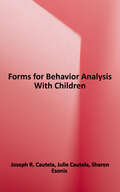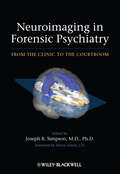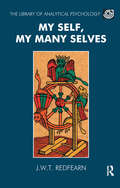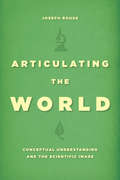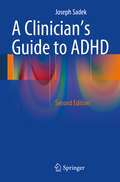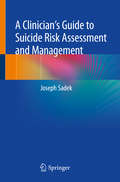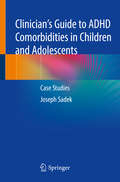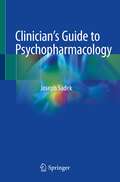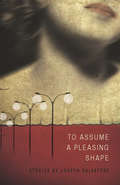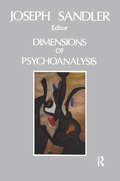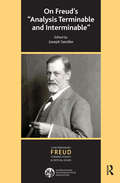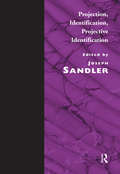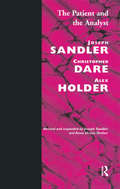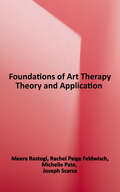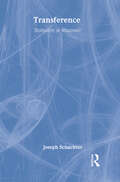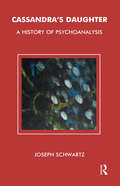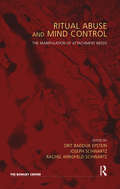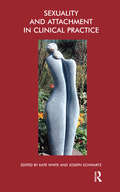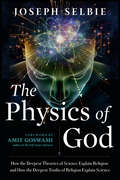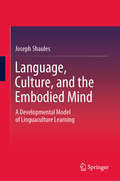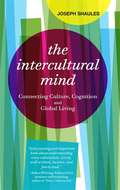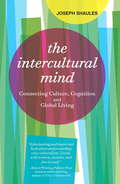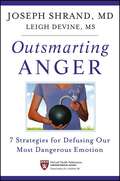- Table View
- List View
Forms for Behavior Analysis With Children
by Joseph R. Cautela Julie Cautela Sharon EsonisA unique collection of 42 reproducible assessment forms designed to aid counselors and therapists in making proper diagnoses and in developing treatment plans for children and adolescents. Different assessment formats are included, ranging from direct observations and interviews to informant ratings and self-reports. Certain forms are to be filled out by children and adolescents, while others are to be completed by parents, school personnel, significant others, or the therapist.
Neuroimaging in Forensic Psychiatry: From the Clinic to the Courtroom
by Joseph R. SimpsonThis important volume is the first to address the use of neuroimaging in civil and criminal forensic contexts and to include discussion of prior precedents and court decisions. Equally useful for practicing psychiatrists and psychologists, it reviews both the legal and ethical consideraitons of neuroimaging.
My Self, My Many Selves
by Joseph Redfearn'The concept of the "self" has remained puzzling and controversial. Indeed, far from gaining clarity, it seems to become ever more complex; for many different people, starting from different premises and having different goals have come to "appropriate" this term. The author has made what seems to me to be a most valuable contribution by sticking firmly to an experiential approach. The author has thought hard and deeply about the different ways in which we experience the "I" and drawn on his own "I" experience as well as on those of his patients and Jung himself. 'The author tells us in his introduction that the main aim of his book is to illustrate the migratory nature of the feeling of "I" and that the goal of analysis is to "facilitate and open up interaction and intercommunication between our various selves".
Articulating the World: Conceptual Understanding and the Scientific Image
by Joseph RouseNaturalism as a guiding philosophy for modern science both disavows any appeal to the supernatural or anything else transcendent to nature, and repudiates any philosophical or religious authority over the workings and conclusions of the sciences. A longstanding paradox within naturalism, however, has been the status of scientific knowledge itself, which seems, at first glance, to be something that transcends and is therefore impossible to conceptualize within scientific naturalism itself. In Articulating the World, Joseph Rouse argues that the most pressing challenge for advocates of naturalism today is precisely this: to understand how to make sense of a scientific conception of nature as itself part of nature, scientifically understood. Drawing upon recent developments in evolutionary biology and the philosophy of science, Rouse defends naturalism in response to this challenge by revising both how we understand our scientific conception of the world and how we situate ourselves within it.
A Clinician's Guide to ADHD
by Joseph SadekThe Clinician's Guide to ADHD combines the useful diagnostic and treatment approaches advocated in different guidelines with insights from other sources, including recent literature reviews and web resources. The aim is to provide clinicians with clear, concise, and reliable advice on how to approach this complex disorder. The guidelines referred to in compiling the book derive from authoritative sources in different regions of the world, including the United States, Canada, Australia, and Europe. After introductory discussion of epidemiology and etiology, guidance is provided on diagnosis in different age groups, differential diagnosis, assessment for potential comorbidities, and the issue of ADHD and driving. Advice is then given on the appropriate use of pharmacological and psychosocial treatment, the management of adverse events, and follow-up. A series of relevant scales, questionnaires, and websites are also included.
A Clinician’s Guide to Suicide Risk Assessment and Management
by Joseph SadekThis book offers mental health clinicians a comprehensive guide to assessing and managing suicide risk. Suicide has now come to be understood as a multidimensionally determined outcome, which stems from the complex interaction of biological, genetic, psychological, sociological and environmental factors. Based on recent evidence and an extensive literature review, the book provides straightforward, essential information that can easily be applied in a wide variety of disciplines.
Clinician’s Guide to ADHD Comorbidities in Children and Adolescents: Case Studies
by Joseph SadekThe diagnosis and management of ADHD co-occurring with other disorders such as anxiety, depression, tics and substance use remain major challenges for clinicians treating all age groups. This book guides clinicians trough each step in the diagnosis and management of the comorbidity through essential case studies describing psychiatric disorders that frequently occur with child ADHD are well described in every case. Each case includes a diagnosis section and management section and is accompanied by questions and answers concerning the most important aspects in diagnosing and managing of both ADHD and the comorbid disorders. Drawn from actual clinical encounters, the case studies also feature ample current and valid references.
Clinician’s Guide to Adult ADHD Comorbidities: Case Studies
by Joseph SadekThe diagnosis and management of ADHD co-occurring with other disorders such as anxiety, depression and personality disorders remain major challenges for clinicians treating all age groups. This book guides clinicians through each step in the diagnosis and management of the comorbidities of adult ADHD on the basis of essential case studies describing psychiatric disorders that frequently occur with ADHD. Each case includes a diagnosis section and management section and is accompanied by questions and answers concerning the most important aspects in diagnosing and managing both ADHD and the comorbid disorders. Drawn from actual clinical encounters, the case studies also feature ample current and valid references.
Clinician’s Guide to Psychopharmacology
by Joseph SadekThis book employs a direct and clear approach to understanding the medications used in the treatment of psychiatric disorders. A range of areas, such as prescription errors, dosage modification in renal and hepatic dysfunction, augmentation strategies in treatment resistant patients, and recent findings from various clinical trials are addressed. Given its clear, straightforward approach, the book will be a valuable guide for all clinicians working with patients with psychiatric illness.
To Assume a Pleasing Shape
by Joseph SalvatoreA body-pierced goth girl cage-dances for a living while putting herself through school. A New York City academic reevaluates her closest relationships while considering breast-reduction surgery. A chatty Gulf War veteran is plagued by a sexual identity crisis. The characters in this debut short story collection search for meaning through the crucible of sex. Joseph Salvatore's top-notch literary writing coaxes readers into murky territories as characters spiral deeper into existential rabbit holes. Joseph Salvatore reviews fiction for The New York Times Book Review. He teaches at The New School where he founded their literary journal LIT. He lives in New York.
To Assume a Pleasing Shape (American Readers Series)
by Joseph SalvatoreA body-pierced goth girl cage-dances for a living while putting herself through school. A New York City academic reevaluates her closest relationships while considering breast-reduction surgery. A chatty Gulf War veteran is plagued by a sexual identity crisis. The characters in this debut short story collection search for meaning through the crucible of sex. Joseph Salvatore's top-notch literary writing coaxes readers into murky territories as characters spiral deeper into existential rabbit holes. Joseph Salvatore reviews fiction for The New York Times Book Review. He teaches at The New School where he founded their literary journal LIT. He lives in New York.
Dimensions of Psychoanalysis: A Selection of Papers Presented at the Freud Memorial Lectures
by Joseph SandlerThis book contains a selection of the Sigmund Freud Memorial Lectures on psychoanalytic psychology delivered by eminent British, French and American analysts, pointing out that there is a tendency to consider pathological processes in terms of the vicissitudes of the person's object relationships.
On Freud's Analysis Terminable and Interminable (Ipa - The Contemporary Freud: Turning Points And Critical Issues Ser.)
by Joseph SandlerA discussion by several analysts on the length of treatment, based upon Freud's paper, which is also included. Contributors include Andre Green, Arnold Cooper and David Rosenfeld.
Projection, Identification, Projective Identification
by Joseph SandlerThis book focuses on all aspects of projection and identification, and addresses the problems and perplexities of projective identification. It is based on the First Conference of the Sigmund Freud Center of the Hebrew University of Jerusalem.
The Patient and the Analyst: The Basis of the Psychoanalytic Process
by Joseph SandlerThis is a completely revised and enlarged edition of the well-known classic. In the twenty years since the previous edition was published much progress has been made in regard to the clinical concept of psychoanalysis, and this new edition brings the subject completely up to date. New knowledge of the psychoanalytic process has been added, together with advances in understanding the clinical situation, the treatment alliance, transference, countertransference, resistance, the negative therapeutic reaction, acting out, interpretations and other interventions, insight, and working through. The book is both a readable introduction to the subject and an authorities work of reference.
Foundations of Art Therapy: Theory and Applications
by Joseph Scarce Meera Rastogi Rachel P. Feldwisch Michelle PateThis is an essential and comprehensive introduction to the field of art therapy that blends relevant psychological and neuroscience research, theories, and concepts and infuses cultural diversity throughout each chapter. <p><p>The text includes full color photos, informative charts, and case examples and is divided into four parts beginning with the basics of art therapy knowledge and concluding with professional practices in art therapy. The fundamentals of art therapy section includes coverage of art therapy founders, art materials, multicultural perspectives, intersections with neuroscience, and research methods. <p><p>An overview and in-depth explorations of different theoretical approaches to the practice of art therapy are covered in the second part of the book. A bio-psycho-social approach integrates current research on art therapy with specific populations (children, mental health, older adults, and trauma). <p><p>The book concludes with art therapy professional practices in group concepts, community-based art therapy, and developing a career in the field. Each chapter contains chapter objectives, practical applications, ethical considerations, reflection questions, experiential exercises, and a list of terms. The unique, practical, and interdisciplinary approach of this text provides a solid base for understanding the field of art therapy and is well suited for use in undergraduate art therapy courses. This book will appeal to those who want an introduction to the field's theories, research, and practice and those seeking a comprehensive understanding on the foundations of art therapy.
Transference: Shibboleth or Albatross?
by Joseph SchachterThe theory of transference and the centrality of transference interpretation have been hallmarks of psychoanalysis since its inception. But the time has come to subject traditional theory and practice to careful, critical scrutiny in the light of contemporary science. So holds Joseph Schachter, whose Transference: Shibboleth or Albatross? undertakes this timely and thought-provoking task. After identifying the weaknesses and inconsistencies in Freud's original premises about transference, Schachter demonstrates how contemporary developmental research across a variety of domains effectively overturns any theory that posits a linear deterministic relationship between early childhood and adult psychic functioning, including the adult patient's treatment behavior toward the analyst. No less trenchantly, he shows how contemporary chaos theory complements developmental research by making the very endeavor of historical reconstruction - of backward prediction - suspect on logical grounds. Nor, Schacter continues, does the clinical evidence normally adduced in support of transference theory provide the firm bedrock of data that most analysts suppose to exist. What one finds, he holds, are endlessly reiterated claims of identifying determining historical antecedents sustained only by descriptions of current behaviors through a gloss of theory. Less a polemic than a call to order, Transference: Shibboleth or Albatross? is cogently argued and straightforwardly written. It is destined to be a thorn in the side of analysts who resist change and a spur to those who seek to bring analytic theory into closer alignment with contemporary science in the interest of improves treatment efficacy.
Cassandra's Daughter: A History of Psychoanalysis
by Joseph SchwartzThis work presents a complete history of psychoanalysis from its origins in 19th-century medical science to the end of the 20th century. The origins of psychoanalysis as well as the more immediate influences on Freud are explored, as is the way the discipline he founded has developed and changed.Joseph Schwartz first lays out the late Victorian approaches to mental illness and health and explains the context in which Freud's revolution took place. He traces the evolution of Freud's own thought, then shows how and why the rifts and shifts in the analytic community occurred. He then focuses on Freud's colleagues, rivals, successors and detractors - Jung, Adler, Sullivan, Melanie Klein, Erich Fromm to name a few. For once we see how the different schools and interpretations fit together - how they grew in response to each other, and what separate contributions each pioneer made over the last hundred years to create an effective understanding of the world of human subjective experience.
Ritual Abuse and Mind Control: The Manipulation of Attachment Needs
by Joseph Schwartz Orit Badouk Epstein Rachel Wingfield SchwartzPeople who have survived ritual abuse or mind control experiments have often been silenced, accused of lying, mocked and disbelieved. Clinicians working with survivors often find themselves isolated, facing the same levels of disbelief and denial from other professionals within the mental health field. This report - based on proceedings from a conference on the subject - presents knowledge and experience from both clinicians and survivors to promote understanding and recovery from organized and ritual abuse, mind control and programming. The book combines clinical presentations, survivors' voices, and research material to help address the ways in which we can work clinically with mind control and cult programming from the perspective of relational psychotherapy.
Sexuality and Attachment in Clinical Practice (The Bowlby Centre Monograph Series)
by Kate White Joseph SchwartzThis book is a selection of papers from the eleventh John Bowlby Memorial Conference. It covers the themes of sexuality and attachment, providing from a historical overview through intricate theoretical pathways to vivid descriptions to both analyst and analysand of a therapeutic relationship.
The Physics of God: How the Deepest Theories of Science Explain Religion and How the Deepest Truths of Religion Explain Science
by Joseph Selbie“An impressive and thought-provoking work . . . regarding the metaphysical mysteries of life, physical reality, and human consciousness. Highly recommended!” —Spirituality TodayScience and religion are often thought to be in conflict. But the contemporary fields of relativity, quantum physics, neuroscience, and more are in agreement with the transcendent phenomena described by saints, sages, and near-death experiencers. Today’s science actually provides profound insight into miracles, immortality, heaven, God, and transcendent awareness.The Physics of God describes the intersections of science and religion with colorful, easy-to-understand metaphors, making abstruse subjects within both science and religion easily accessible to the layman. This intriguing book:Pulls back the curtain on the light-show illusion we call matter.Connects string theory to religion’s transcendent heavens.Reveals the scientific secret of life and immortality.Demonstrates the miracle-making power of our minds to effect instantaneous physiological changes.Included in this revised edition is a new chapter on the physics of meditation and other updates.
Language, Culture, and the Embodied Mind: A Developmental Model of Linguaculture Learning
by Joseph ShaulesThere is an odd contradiction at the heart of language and culture learning: Language and culture are, so to speak, two sides of a single coin—language reflects the thinking, values and worldview of its speakers. Despite this, there is a persistent split between language and culture in the classroom. Foreign language pedagogy is often conceptualized in terms of gaining knowledge and practicing skills, while cultural learning goals are often conceptualized in abstract terms, such as awareness or criticality.This book helps resolve this dilemma. Informed by brain and mind sciences, its core message is that language and culture learning can both be seen as a single, interrelated process—the embodiment of dynamic systems of meaning into the intuitive mind. This deep learning process is detailed in the form of the Developmental Model of Linguaculture Learning (DMLL). Grounded in dynamic skill theory, the DMLL describes four developmental levels of language and culture learning, which represents a subtle, yet important shift in language and culture pedagogy. Rather than asking how to add culture into language education, we should be seeking ways to make language and culture learning deeper—more integrated, embodied, experiential and transformational. This book provides a theoretical approach, including practical examples, for doing so.
The Intercultural Mind: Connecting Culture, Cognition And Global Living
by Joseph ShaulesIn this pioneering book, Joseph Shaules explores exciting new research in cultural psychology and neuroscience, and explains how the new science of the mind can help us understand how the unconscious mind processes cultural differences, and how our sense of identity shapes how we view the world.The Intercultural Mind presents new perspectives on important questions such as:What is culture shock, and how does it affect us?Why are we blind to our own cultural conditioning?Can cultural differences be measured?What does it mean to have an international mindset?Illustrated with a wealth of examples and memorable stories, The Intercultural Mind is a fascinating look at how intercultural experiences can transform the geography of thinking.
The Intercultural Mind: Connecting Culture, Cognition, and Global Living
by Joseph ShaulesIn this pioneering book, Joseph Shaules presents exciting new research from cultural psychology and neuroscience. It sheds light on the hidden influence of culture on the unconscious mind, and helps people get more out of their intercultural journeys.The Intercultural Mind presents new perspectives on important questions such as: What is culture shock, and how does it affect us? Why are we blind to our own cultural conditioning? Can cultural differences be measured? What does it mean to have an international mindset? Illustrated with a wealth of examples and memorable stories, The Intercultural Mind is a fascinating look at how intercultural experiences can transform the geography of our minds.
Outsmarting Anger: 7 Strategies for Defusing Our Most Dangerous Emotion
by Joseph Shrand Leigh DevineSurefire strategies for transforming anger in yourself and others In this must-have resource, Dr. Joseph Shrand offers seven innovative yet remarkably uncomplicated strategies to help turn powerful anger impulses into positive, success-oriented actions. <P><P>These brain-based techniques teach you how to recognize the many forms of anger we all experience, and how to tap into your brain's very own anger absorption zone the prefrontal cortex. Dr. Shrand also explores the ways these techniques can be used to harness the anger of others. When we learn to recognize and defuse the anger response of any individual, we improve our chances for success in every aspect of life.Explains how the power of anger can be turned into much more productive behaviorsOutlines 7 simple strategies for outsmarting the lizard brain and the primitive limbic systemPublished in partnership with Harvard Health publications, a division of Harvard Medical SchoolOutsmarting Anger helps you manage and decrease not only your own anger, but the anger of people around you so everyone can be more successful.
